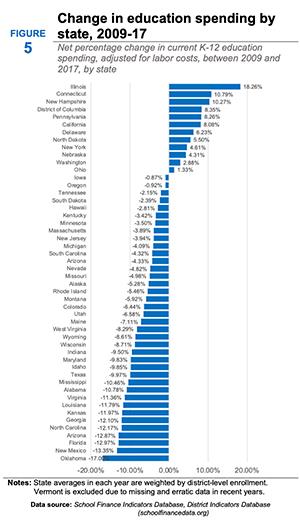The economic impact of the coronavirus pandemic threatens to devastate the state budgets that fund public schools, but a new report from the Albert Shanker Institute outlines a viable path to minimizing the damage. The report, released April 24, calls on the federal government to pump money into the system in the short-term, while relying on states to secure funding and build up infrastructure to weather future downturns.
“The Coronavirus Pandemic and K-12 Education Funding” turns to recent history for lessons learned from the persistent damage wrought on education funding by the 2007-09 Great Recession, which was widespread and generally worse for higher-poverty districts. By 2017, the last year for which national data are available, funding in many states still had not recovered to pre-recession levels. For years, too many states had failed to invest in their public schools and as a result, they were extremely vulnerable when the recession hit, and ill-equipped to recover quickly even when the economy improved.
The new report lays out a plan to avoid repeating this disaster. “We can’t forfeit our students’ future because of the coronavirus pandemic,” says AFT President Randi Weingarten. “This report makes clear a generation of students will be lost if we fail to learn the lessons of the Great Recession.”
States must step up
Crucially, the report asserts that states cannot rely on federal aid and will have to reform their own school finance systems to recover fully. “States cannot continue business as usual,” explains co-author Bruce Baker, professor in the Department of Educational Theory, Policy and Administration at Rutgers University. “If they once again rely on federal aid to help them during this recession and recovery without putting their own houses in order, they risk prolonging the damage, and they will also be less prepared to weather economic downturns in the future.”
In the “layer cake” of public education money, Baker explained during a panel discussion of the report April 24, state and local governments provide a whopping 90 percent of school funding. And while it is expensive to shore up school spending within a state budget, avoiding the issue could create the second “once-in-a-lifetime” education funding disaster within a 15-year period, with particular harm to our nation’s most vulnerable students.
The federal government has a role to play, too: In fact, its 2009 post-recession stimulus package was successful in some ways. But its short duration (two years) created a fiscal “cliff” when the funding ran out, and states wound up making drastic cuts that caused disproportionate harm to higher-poverty districts, which are more dependent on state revenue.
Finding a solution
Starting immediately, the report recommends that the federation government pass a large aid package with K-12 stabilization funds above those already provided by the CARES Act; enact the package in two phases, with two years of substantial funding followed by three to five years of phase-down effort, to avoid a fiscal “cliff”; distribute the funding equitably, according to student needs; and create eligibility requirements that prohibit states from cutting higher-poverty districts disproportionately, and from enacting fiscal austerity measures like tax caps.
For states, the report recommends restoring education spending, through federal policy incentives if necessary, to pre-Great Recession levels; building up budget reserves; practicing more progressive allocation of funding, with higher-poverty districts receiving more funding than lower-poverty districts; and more strategically balancing revenue sources among income, sales and property taxes.
We can do this
Sylvia Allegretto, co-chair of the Center on Wage and Employment Dynamics at the Institute for Research on Labor and Employment at the University of California, Berkeley, who was part of the April 24 panel, is hopeful that the public will support increased education funding. With parents tasked with teaching their children at home—and some suggesting on social media that teachers be paid millions for their patience and expertise—there is a new awareness of the importance of public schools. “We’re going to have the power of the people,” says Allegretto. “They are going to revolt if they see the school system starting to fall apart in front of them.”
Pedro Noguera, distinguished professor of education at the Graduate School of Education and Information Studies at UCLA, says the crisis has shown public education to be “a critical part of the social safety net. Without it, there are a lot of kids whose basic needs will go unmet. Just as the police and fire departments and our healthcare system are vital to the functioning of our society, so are our schools.”
Joshua Starr, chief executive officer of PDK International and former superintendent of schools in Montgomery County, Md., fears this vital foundation will be battered by the time the children finally return to school. In particular, “imbalances in funding oppress many and privilege few,” he says. “We are already starting to see an increased challenge around equity issues in our schools. And then we’re going to come back to school, and there’s going to be a lot less money.”
“Unless we act now to secure federal and state aid for public schools, we are destined to add to the toll austerity has wrought on kids over the last decade: higher class sizes, widening inequality and more segregation,” says Weingarten. “The challenges are immense, but we are not powerless actors subject to the whims of history—we can intervene if we’re serious about funding our kids’, and our nation’s, future.”
[Virginia Myers]


